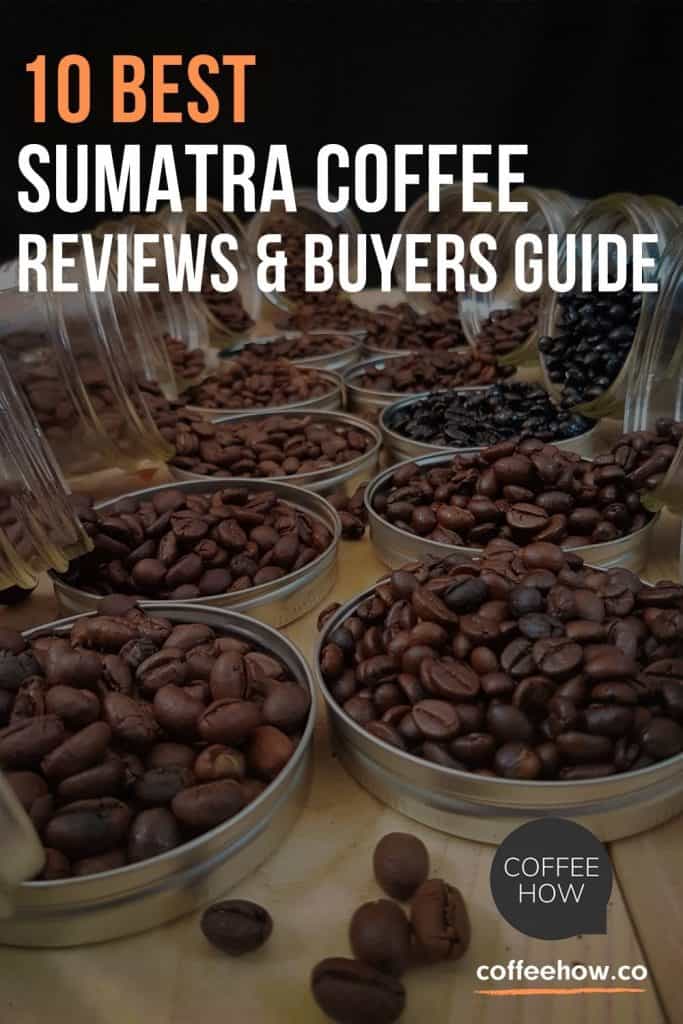fbq('trackCustom', 'view_shop_coffee'); var trackEvent = 'shop_coffee'; There seems to be a growing trend of drinking…
Do you love a dark, rich, fully flavored cup of coffee? If yes, you might want to try Sumatra coffee. The bonus is that it’s naturally low in acidity.
People either love or hate coffee from Sumatra. But what is Sumatra coffee? It has a flavor as exotic as where it’s from. Sumatra is an island in Indonesia. Indonesia is the fourth largest coffee producing country in the world.
Coffee from the island of Sumatra has a reputation for a unique, earthy flavor. It has a full body that holds up well to additives like cream and sugar. The taste comes in part from the unusual coffee processing technique called wet hulling. No one knows how the process developed. Sumatra is virtually the only place that processes the beans this way. We’ll talk more about the process later in the article.
A premium variety is Mandheling. This coffee has a distinctive flavor profile. In a study, three out of four blind tasters picked the Mandheling out of 42 samples!
Are you ready to walk on the wild side? Choose the best Sumatra coffee from our list below to expand your horizons.
Our top recommendation must be the Sumatra Mandheling coffee from Volcanica. This coffee checks all the boxes for sustainable farming. It has the classic flavor profile you expect from a Sumatran. You know it will be fresh. They only roast to order.
Check priceFor many decades, Starbucks has been importing Sumatra beans into the US. More recently, smaller specialty-roasters have been getting in on the action. To help you decide which Sumatran to buy, we’ve rounded up the top contenders.
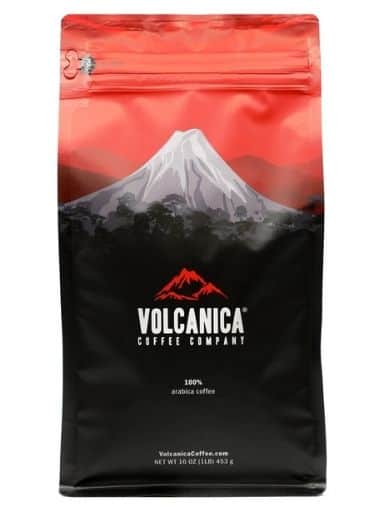
Volcanica is a well-established coffee brand. Several of their coffees appear on our list of best Sumatra coffee. They roast their coffee weekly in their Atlanta location. Besides their commitment to fine specialty coffee, they also give back. They donate 1% of sales to charity: water.
Volcanica roasts their Sumatra Mandheling to medium. This lighter roast allows the flavor notes of lemongrass and dried fruit to come forward. Yet it still has the earthy, chocolate flavors that coffee from Sumatra is known for. Toffee, brown sugar, and caramel complete the flavor profile.
These beans come from Sumatra Utara, the Indonesian word for north Sumatra. This coffee is undergoes the traditional wet hulling process Sumatra is known for. Sumatra Mandheling is Fair Trade Certified and Certified Kosher.
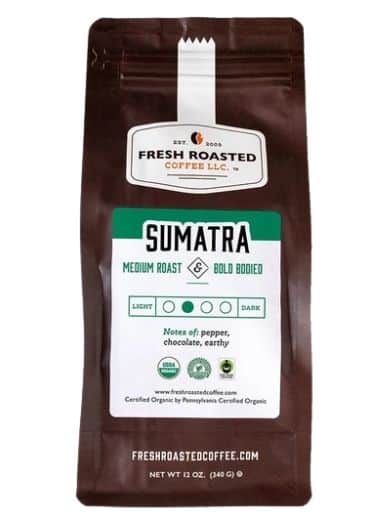
Fresh Roasted Coffee LLC is committed to protecting the environment. They carry USDA Organic, Fair Trade, Rainforest Alliance, and Smithsonian Migratory Bird Center Bird Friendly certification. They also offer Kosher products.
Beyond that, they use a smokeless roasting process. This helps eliminate their carbon footprint by 80%
But none of that matters if the coffee doesn’t taste good. And this organic Sumatra delivers. It hails from the Central Aceh region. The coffee beans are sources from a co-op with over 890 growers and members. They grow the coffee plants between 4,000- and 5,000-feet elevation. Varietals include Catimor, Bourbon, Typica, and Caturra.
They process the coffee with the traditional wet hulled, sun dried method. In addition to the earthy, chocolate profile, this coffee offers a peppery flavor. In this medium-roasted coffee, you might also detect slight vegetal notes. It is rich and full-bodied.

As noted above, Volcanica is a brand you can trust to deliver fine coffee in an ethical manner. Their Sumatran Gayo is an Orang-Utan Conservation coffee. It’s described as being clean and spicy. It employs the wet hulled process.
This medium roast offers caramel, peach, wisteria, and chocolate flavor notes. The body is lighter than many other Sumatran coffees. Like all Volcanica coffees, the Sumatran Gayo is only roasted after you place your order.
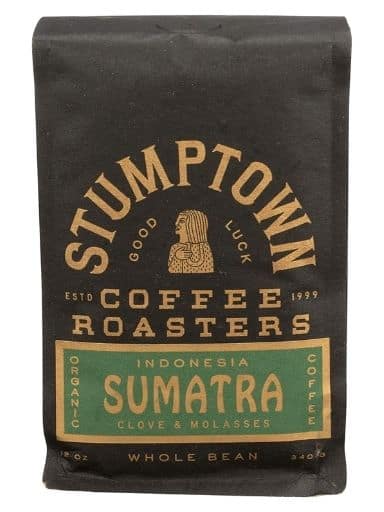
The beans for Stumptown’s Bies Penantan coffee come from smallholder farmers in Sumatra’s Aceh province. The coffee is named for the community that produces it. It’s grown between 4,000 and 5,200 feet in elevation. It is wet hulled
This coffee comes exclusively from the Ketiara Cooperative. The co-op is female-led. It was founded in 2009. It seeks to build upon the empowerment to growers that fair trade coffee started.
Varietals include Bourbon, Typica, Caturra, and Catimor. The resulting brew is full bodied. This medium roast carries sweet notes of cedar and spice. Some tasters detect blackberry notes along with the typical earthy, chocolate flavor profile.

Peaberries are actually a defect of the coffee cherry. Rather than two flat beans, some cherries only develop a single, more rounded bean. This usually affects about 5% to 10% of the harvest. Many believe that the single seed allows the flavor to develop more fully.
Therefore, the Sumatra Gayo Peaberry has all the qualities of the regular Gayo, and then some. This coffee is grown between 4,500 and 6,000 feet in elevation. You’ll notice a dark herbal flavor like cardamom and cloves. Other flavor notes include caramel, peach, wisteria, and dark chocolate.
The beans are Direct Trade and Kosher certified. It comes in a medium roast with a smooth body and heavy syrupy aftertaste. They are wet hulled and have a crisper taste than many other Sumatran coffees.

These beans come from the Lintong area of Sumatra. Lintong beans have a balanced flavor with a clean aftertaste.
A unique point of this coffee is that they age the beans in whiskey barrels from the Sons of Liberty distillery. This process lends a vanilla and caramel sweetness. Tasting notes include woody and earthy with a mild tobacco essence. The brew also carries a hint of ripe tropical fruits.
This is one of the few Sumatran coffees that are recommended for an espresso machine. You will also get an excellent beverage using a drip, pour-over, or French Press method.
This coffee carries the organic certification and has a Fairtrade Grade 1 rating. It is dark roasted. This is a good coffee to try for its unique aging process.

If you love Sumatra Mendheling but don’t want the caffeine, then try this coffee. You get all the rich, bold flavor of the original. It comes from the Utara area of Sumatra.
The Swiss Water Process removes caffeine without changing the taste. You are left with a rich cup of decaf coffee with a full body. You’ll enjoy the earthy flavor with a syrupy aftertaste. This will help you keep calm and coffee on.
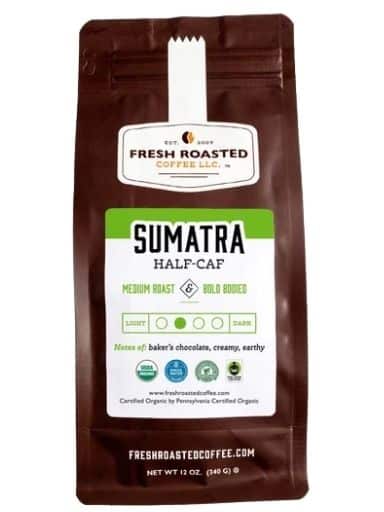
This coffee has all the certifications the environmentally conscious consumer looks for. It is USDA Organic, Fair Trade, Rainforest Alliance, and Kosher certified. The beans grow in the shade to protect the harvesters and bring the best flavor.
This brew has all the qualities of the Fresh Roasted Coffee Organic Sumatra listed above. But it has dramatically less caffeine. They use the Swiss Water Process method of removing the caffeine. This method leaves all the rich, bold flavor without the astringent taste you can get with some decaf coffees.
Cupping notes include earthy, creamy, and baker’s chocolate. This medium roast coffee has a bold body with loads of rich flavor.

This is one of just a few dark roast coffees on our list. As with the other two Volcanica Sumatra Mandheling coffees on this list, it is from the Utara area in Sumatra. It gives the rich, earthy goodness of their regular Sumatra Mandheling, and then some.
The darker roast brings out the brown sugar, wine, and dried fruit flavors of this bean. Overall, it has a more exotic taste. It is shade grown, Fair Trade and Kosher certified.
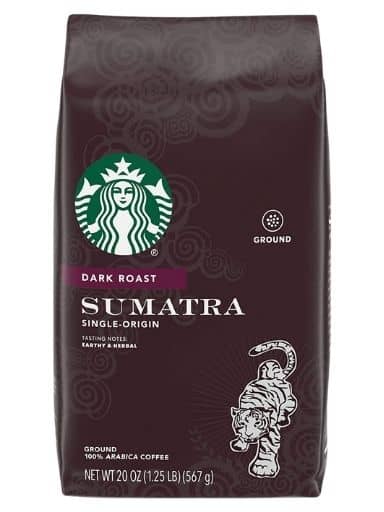
Starbucks’ Dark Roast Sumatra is another dark roast on our list. The tasting notes are herbal and earthy. Starbucks is one of the primary buyers of southeast Asian coffees. It is the bass note of many of their blends, and you can also get it as a single-origin coffee.
This brew exhibits the typical rich chocolate notes and full body you expect in a Sumatran. The deep flavor pairs well with sweet breakfast treats. Starbucks Dark Roast Sumatra gives a smooth mouthfeel and is very low acid. If you’d like to try the exotic taste of Sumatran coffee without breaking the bank, this may be a good place to start.

Dutch colonialists first brought arabica coffee beans to Indonesia in the late 1600s. Although the plant isn’t native, the tropical climate, heavy rains, and high volcanic mountains were a perfect fit. Coffee plants flourished and exporters began a vigorous trade.
Once established, Indonesian was the largest coffee producer in the world. Unfortunately, all the plants were the same varietal. Coffee rust, a disease common to coffee, nearly wiped out all the plantations around the end of the 19th century. The lower elevations were especially devastated.
The Dutch colonial government decided to replant with the robusta coffee plant. It’s more resistant to disease, has more caffeine, but it doesn’t taste as good as arabica. Most of the coffee produced in Indonesia these days is robusta.
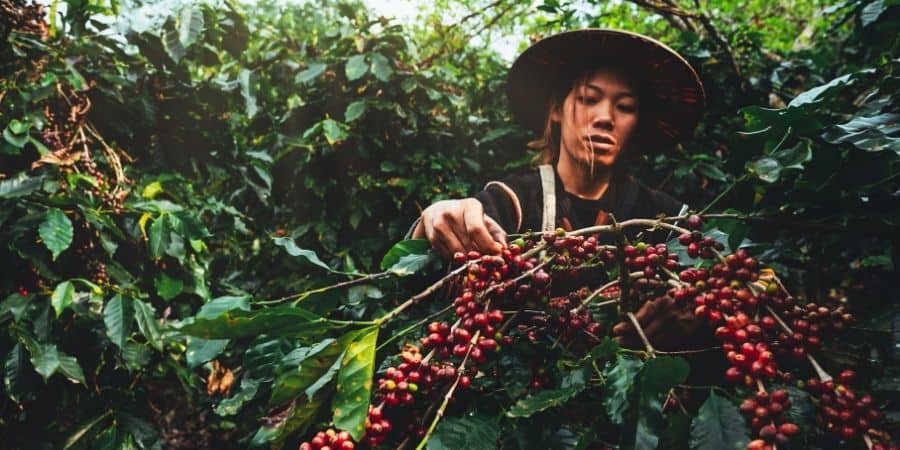
However, the plants in the highlands of Indonesia, such as in northern Sumatra, were not as affected by the coffee rust disease. Arabica plants grow well there, so they replanted with different arabica varietals. Today, northern Sumatra primarily produces arabica beans.
In Sumatra, coffee is mostly grown on small farms. In fact, most landholders only haver one or two acres to farm. These farms are banding together to form cooperatives. This not only helps the farmers, but it also ensures a better product. They can pool resources to upgrade their techniques.
History is interesting, but it’s all about taste. Sumatran has one of the most distinctive flavor profiles. It’s usually described as earthy and chocolatey. People who aren’t fans may call it mushroomy or funky. But you can’t deny its rich, smooth body. The wet hulling process that is used in Sumatra brings these properties.
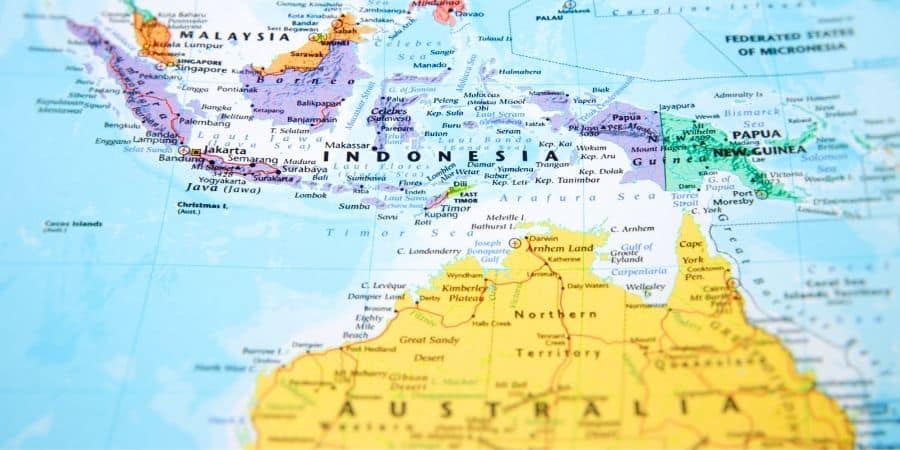
Sumatra is the westernmost island of Indonesia. It’s also the largest island that is entirely in Indonesia.
It doesn’t get more tropical than Sumatra. The equator passes through the middle of the island. As of 2014, over 50 million people live on the island. However, away from the cities, Sumatra offers expanses of untouched areas. Sumatra is also known for its rare orangutans.
The island can be divided into three main parts: north, south, and west. The northern part of the island is mainly high volcanic mountains. That’s where the rich coffee comes from. It’s also the most popular for tourists.
Coffee in this region is grown by small landholders. As with most coffee grown in mountainous regions, workers harvest the coffee cherries by hand. Many of these farms have gotten Fair Trade, Organic, Rain Forrest, and other environmentally friendly certifications. This helps ensure that the farms will continue for many generations to come.
Acidity in coffee can be a good or a bad thing. It’s what gives the cup a brightness or liveliness. But acidity in coffee can also cause stomach problems. For that reason, many people who have digestive issues look for a low-acid coffee.
Many things affect a coffee’s acidity. The roast level has a huge impact. In general, a darker roast has a lower acidity.
Brewing method also contributes to acidity. The brewing method for the lowest acidity is cold brewing. For a hot drink, the French Press is also a low-acid technique. On the opposite end, espresso machines produce coffee with the highest acidity.
But a coffee’s origin has maybe the biggest impact. Coffee from Sumatra is known to be low acid. The low acidity is partly because of growing condition. But it may also be from the unique wet hulling process. If you’re looking for a low-acid coffee packed with flavor, Sumatra is a good place to start.

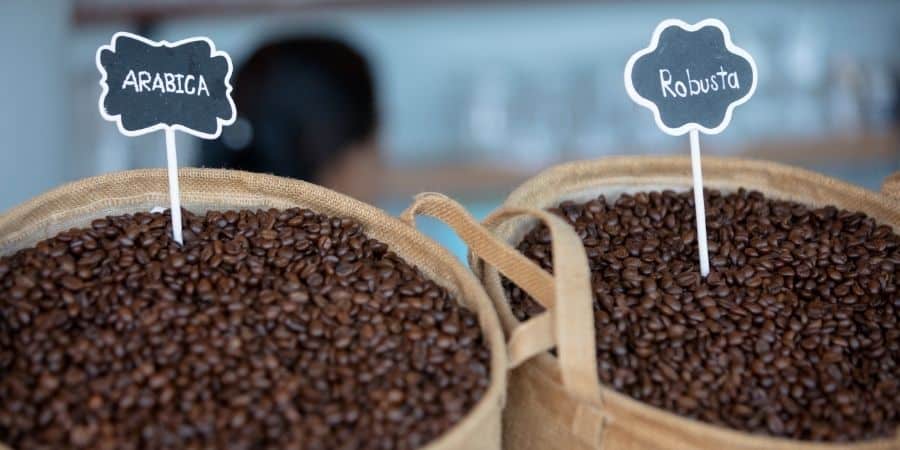
In the broadest sense, there are two types of coffee: arabica and robusta. You probably know that robusta is higher in caffeine but does not taste particularly good. Pretty much all specialty coffee is an arabica varietal.
Northern Sumatra grows arabica beans of a few different varietals. Originally, growers planted the Typica varietal. But much of that was wiped out by coffee leaf rust. However, you can find a mutated Typica Mandheling and Typica Lintong. Other common varietals on the island include Catimor, Bourbon, and Caturra.
When talking about sourcing for coffee, you’ll usually hear three different designations: Mandheling, Lintong, and Gayo. Mandheling is the most common. It comes from the North Sumatra province. It’s known for its earthy chocolate notes.
Lintong is also a growing region in North Sumatra. The coffee here is grown on a high plateau. It’s known for having a full flavor and clean aftertaste.
Gayo coffee comes from the Aceh province at the northern tip of Sumatra. Elevations for these coffees range from 4,500 to 6,000 feet. Most farmer employ shade-grown techniques. These beans are often more intensely flavored that from other regions. In addition to the typical Sumatra profile, Gayo beans commonly have hints of cardamom, peach, and caramel.
It’s wet in Sumatra. Really wet. Rainfall in Sumatra is around 200 inches a year. Other coffee growing regions, such as Colombia, get less than half that. That’s why coffee growers in Sumatra had to develop a unique coffee processing. Almost every day would bring at least a little bit of rain.
As a result, it was near impossible for the small farmers to fully dry the coffee beans. They developed a unique hybrid process called wet hulling. It’s called giling basah in the local language.
To understand this process, it’s important to understand the parts of the coffee cherry. The innermost layer is the coffee bean, which is actually the seed. Surrounding that is the parchment, also called the hull. Around that is a thick, gluey layer called the mucilage. Then you have the fruit and skin.
Right after picking, the workers pulp the coffee cherries. They typically put the cherries in a hand-crank machine to remove the skin and the fruit. Then they put the beans into bags to ferment for a day or two. That helps break down the mucilage.
The next step is washing the beans to remove the mucilage. Now you’re left with the wet parchment coffee. They leave the beans for a few days to dry.
The problem in Sumatra is that things never get completely dry. In other regions they can dry the beans for weeks to about 11% moisture. So, the Sumatran process removes the parchment while it’s still wet. Wet parchment is more difficult to crack than dry. They hull the beans by hand, sometimes with a crude machine made just for this purpose.
After hulling, the beans dry again. Typically, they let the beans dry in the sun during the sun during the day. They are then bagged at night and put under cover. This process allows the beans to continue to ferment. When the hulled beans reach about 12% moisture, they are ready for export.
We hope we’ve answered all your questions about what is Sumatra coffee. We’ve also given you several options for exploring the rich experience of this unique beverage. You can’t go wrong with any of these options. But which one will you try?
Our top recommendation must be the Sumatra Mandheling coffee from Volcanica. First, this coffee checks all the boxes for sustainable farming. They build relationships with the farmers and co-ops.
Second, it has the classic flavor profile you expect from a Sumatran. The bold and rich flavor with chocolate notes shines through. But the taste is not muddy. You also get a noticeable sweetness. The low acid and full body make for a satisfying cup of joe.
Third, you know it will be fresh. They only roast to order, so you will never get a bag that has been sitting around for weeks or months.
Still not sure that coffee from Sumatra is worth trying? This video from the Specialty Coffee Association might convince you.
Enjoy the delicious tastes of this South Pacific island paradise.
Sumatra is an island in Indonesia. It’s the largest island that is completely within the Indonesian boundaries. The coffee-producing area is in the mountainous northern part of the island.
Sumatran coffee undergoes a process called wet hulling. This process is unique to Indonesia. It’s what gives Sumatra Coffee its signature flavor profile.
You either love it or hate it. (Personally, I love it.) It has a full body, almost syrupy, and is very low in acidity. The complex flavor has notable chocolate tones with a slight earthiness.
As far as caffeine content, Sumatran coffee has slightly less caffeine than your average cup of coffee. But when it comes to taste, Sumatra has a big, bold flavor that is unmistakable.
While much of the Indonesian island consists of lowlands, the northern part of Sumatra has high mountains. Most of the specialty Sumatran coffee grows between 4,000 and 5000 feet in elevation.
